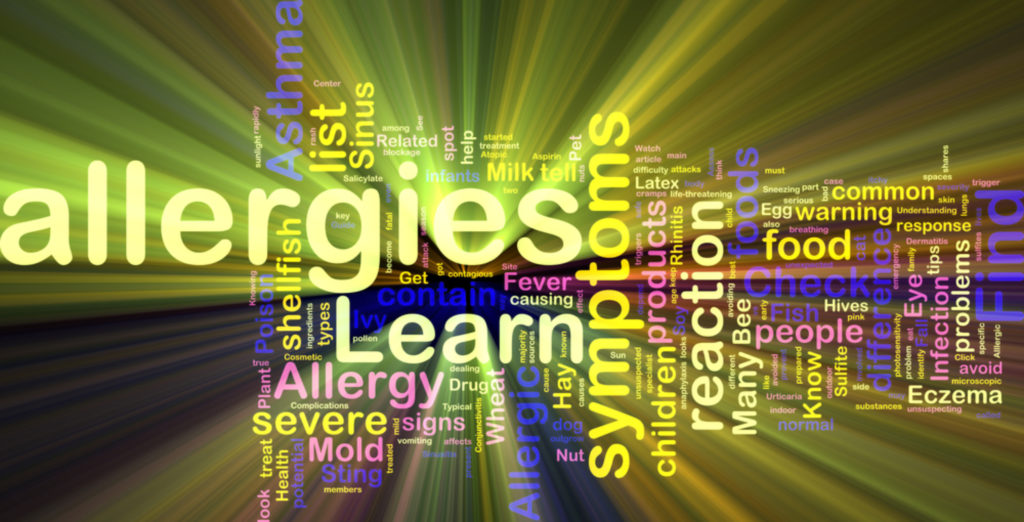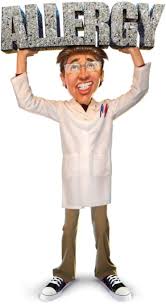
Contents
First aid – Allergies:
Definition:
An allergy occurs when the body overreacts to an allergen or ‘trigger’ that is typically harmless to most people. Examples of allergies include hay fever, asthma, eczema, hives and food allergy. Estimates suggest that about one person in four is allergic to something and roughly half of all allergy sufferers are children.
The symptoms of an allergy range from mild to severe. The most severe type of allergic reaction is anaphylaxis, which may cause death without prompt medical attention. In most cases, effective treatments are available to manage or treat allergy symptoms.
Anaphylaxis is a severe allergic reaction and potentially life threatening. It should always be treated as a medical emergency, requiring immediate treatment. Most cases of anaphylaxis occur after a person with a severe allergy is exposed to the allergen they are allergic to (usually a food, insect or medication).
Common allergens
A substance in the environment that can cause an allergic reaction in susceptible people is called an ‘allergen’. There are many different allergens, but they all share one thing in common – protein. Some allergens don’t contain protein to begin with, but bind with protein once inside the body to provoke the allergic reaction.
Common allergens include:
- Food – such as crustaceans, eggs, fish, milk, peanuts, tree nuts (for example, almonds, cashews, pecans and walnuts), sesame and soy products.
- Plants – pollen from grasses and plants.
- Medicines from some prescription drugs (such as penicillin), over-the-counter medicines (such as aspirin) and herbal preparations.
- Insects – such as dust mites and the venom from bees, ticks and wasps.
- Moulds – such as mushroom and mould spores.
- Animal dander – such as the fur and skin flakes from domestic pets like cats and dogs.
- Chemicals – including industrial and household chemicals and chemical products such as latex rubber.
Some people have allergy-like reactions to hot or cold temperatures, sunlight, or other environmental triggers. Sometimes, friction (rubbing or roughly stroking the skin) will cause symptoms.
Allergies may make certain medical conditions, such as sinus problems,
- eczema
- asthma
Symptoms depend on the allergy, but may include:
- Sneezing
- Runny nose
- Red, watery and itchy eyes
- Wheezing
- Coughing
- Breathing problems
- Headache
- Skin rash
- Stomach pains
- Vomiting and diarrhoea.
Causes:
Allergies are very common.Both genes & environment play a role.If both your parents have allergies, there is a good chance that you have them, too.
The immune system normally protects the body against harmful substances, such as bacteria and viruses. It also reacts to foreign substances called allergens. These are usually harmless and in most people do not cause a problem.
In a person with allergies, the immune response is oversensitive. When it recognizes an allergen, the immune system launches a response. Chemicals such as histamines are released. These chemicals cause allergy symptoms.
Exams and Tests:
The health care provider will perform a physical exam and ask questions, such as when the allergy occurs.
Allergy testing may be needed to find out whether the symptoms are an actual allergy or are caused by other problems. For example, eating contaminated food (food poisoning) may cause symptoms similar to food allergies. Some medications (such as aspirin and ampicillin) can produce non-allergic reactions, including rashes. A runny nose or cough may actually be due to an infection.
Skin testing is the most common method of allergy testing. One type of skin testing is the prick test. It involves placing a small amount of the suspected allergy-causing substances on the skin, and then slightly pricking the area so the substance moves under the skin. The skin is closely watched for signs of a reaction, which include swelling and redness. Other types of skin tests include patch testing and intradermal testing. Skin testing may be an option for some young children and infants.
Blood tests that may be done include:
- Immunoglobulin E (IgE), which measures levels of allergy-related substances
- Complete blood count
- eosinophil white blood cell count
(CBC) called the
In some cases, the doctor may tell you to avoid certain items to see if you get better, or to use suspected items to see if you feel worse. This is called “use or elimination testing. ” This is often used to check for food or medication allergies.
The doctor may also check your reaction to physical triggers by applying heat, cold, or other stimulation to your body and watching for an allergic response.
Sometimes, a suspected allergen is dissolved and dropped into the lower eyelid to check for an allergic reaction. This should only be done by a health care provider.
Treatment:
Severe allergic reactions (anaphylaxis) need to be treated with a medicine called epinephrine. It can be life-saving when given right away. If you use epinephrine, call emergency and go straight to the hospital.
The best way to reduce symptoms is to avoid what causes your allergies.This is especially important for food and drug allergies.
There are several types of medications to prevent and treat allergies. Which medicine your doctor recommends depends on the type and severity of your symptoms, your age, and overall health.
Illnesses that are caused by allergies (such as asthma, hay fever, and eczema) may need other treatments.
MILD TO MODERATE ALLERGIC REACTION:
In some cases, anaphylaxis is preceded by signs of a mild to moderate allergic reaction:
- Swelling of face, lips and eyes
- Hives or welts on the skin
- Tingling mouth
- Stomach pain, vomiting (these are signs of a mild to moderate allergic reaction to most allergens, however, in insect allergy these are signs of anaphylaxis).
ACTION:
- For insect allergy, flick out the sting if it can be seen (but do not remove ticks)
- Stay with person and call for help
- Give medications if prescribed (whilst antihistamines may be used to treat mild to moderate allergic reactions, if these progress to anaphylaxis then adrenaline is the only suitable medication)
- Locate adrenaline autoinjector if available (instructions are included in the Action Plan for Anaphylaxis which should be stored with the adrenaline auto injector)
- Contact parent/guardian or other emergency contact.
ANAPHYLAXIS (SEVERE ALLERGIC REACTION):
Continue to watch for any one of the following signs of anaphylaxis (severe allergic reaction):
- Difficult/noisy breathing
- Swelling of tongue
- Swelling/tightness in throat
- Difficulty talking and/or hoarse voice
- Wheeze or persistent cough
- Persistent dizziness or collapse
- Pale and floppy (in young children)
ACTION:
- Lay person flat – if breathing is difficult, allow to sit – do not allow them to stand or walk
- Give the adrenaline autoinjector if available (instructions are included in the ASCIA Action Plan for Anaphylaxis, stored with the adrenaline autoinjector)
- Call Ambulance
- Contact parent/guardian or other emergency contact
- Further adrenaline doses may be given (when an additional adrenaline autoinjector is available), if there is no response after 5 minutes.
- If in doubt, give the adrenaline autoinjector.
Prevention:
Breastfeeding can help prevent or decrease allergies when you feed babies this way only for 4 to 6 months. However, changing a mother’s diet during pregnancy or while breastfeeding does not seem to help prevent allergies.
For most children, changing the diet or using special formulas does not seem to prevent allergies. If a parent, brother, sister, or other family member has a history of eczema and allergies, discuss feeding with your child’s doctor.
There is also evidence that being exposed to certain allergens (such as dust mites and cat dander) in the first year of life may prevent some allergies. This is called the “hygiene hypothesis.” It came from the observation that infants on farms tend to have fewer allergies than those who grow up in more sterile environments. However, older children do not seem to benefit.
Once allergies have developed, treating the allergies and carefully avoiding allergy triggers can prevent reactions in the future.
First aid for Allergic reaction
First aid for severe Allergic reaction
